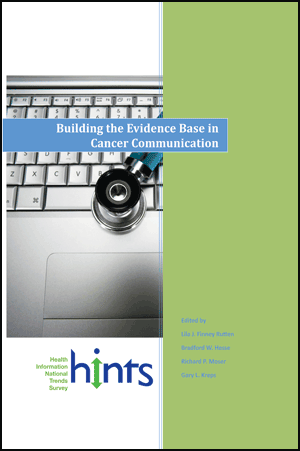Building the Evidence Base in Cancer Communication (Rutten, Hesse, Moser, Kreps) | |
|  | Quantity in Basket:none
Code: 1-57273-943-6
Price:$85.00
Title: Building the Evidence Base in Cancer Communication
Editor(s): Lila J. Finney Rutten, Bradford W. Hesse, Richard P. Moser and Gary L. Kreps
Publish Date: December 2010
Pages: 368
Format: Cloth
| |
| This volume summarizes insights from the May 2007 HINTS Data Users Conference into a format that will be useful for the health communication community at large. Accordingly, each author begins with a tie-in to the National Cancer Institute’s Health Information National Trends Survey as a provocative starting point for their discussions on why and how to collect an evidence base to inform the science and practice of health communication at a time of unprecedented change.
The authors discuss surveillance data as a translational tool for monitoring and understanding the rapidly changing currents of a communication revolution that will most assuredly have a paradigm shifting impact on population health nationally and globally. The book is divided into three major sections. The first section tackles the methodological issues that are confronting administrators of scientific surveys during a time in which the communication technologies upon which these surveys depend are rapidly changing. The second section deals with a moral imperative in health communication research, that of working together to solve issues of health disparities. The third section sets the stage for future considerations in health communication and informatics research. The final section reflects on the lessons from three administrations of the Health Information National Trends Survey. The volume provides grist for the mill to the earnest health communication scientist looking to assess the behavioral and social processes unfolding during the latest, and in some ways most pervasive, communication revolution.
Contents: Health Communication in a World Gone Flat: Programmatic Overview of HINTS, Bradford W. Hesse. SURVEY METHODOLOGY. The Means to an End: Methodology in Surveys of Health Communication, Gordon Willis. Opportunities for Conducting Theory-Relevant Cancer Control Research Using Population-Level Surveys, William Rakowski, Alexander Rothman, and Sarah Kobrin. Cognitive Interview Pretesting of a Health Information Survey: Lessons Learned, Jeffrey Kerwin and Gordon Willis. Implications of Cell Phone Usage in Survey Research for Informing Communication Research & Practice, Michael W. Link. Two Approaches to Address Non-Response:A Case Study with the Health Information National Trends Survey (HINTS), David Cantor. Examining Changes across Years Using Repeated Cross-Sectional Health Surveys, Lou Rizzo, Richard P. Moser, William Waldron, Zhuoqiao Wang, and William W. Davis. EXTENDING REACH IN HEALTH COMMUNICATION. Extending Reach in Health Communication, Erik Augustson. Health Information National Trends Survey: Implications for Addressing Cancer Health Disparities through Public Health Surveillance, Vetta L. Sanders Thompson and Patricia Cavazos-Rehg. Health Communication Channel Preferences by Class, Race, and Place, Kelly D. Blake, Sherrie Flynt-Wallington, and K. Viswanath. Using the Health Information National Trends Survey (HINTS) to Identify Cancer Knowledge Deficits, Jennifer Hay, Soye Zaid-Muhammad, Jennifer S. Ford, and Elliot J. Coups. Health Behaviors and Beliefs among Cancer Survivors, Family Members, and the General Population: The HINTS Perspective, Tenbroeck Smith, Corinne Crammer, and Michael Stefanek. Biological Literacy: A Key to Cancer Prevention and Control in the 21st Century, Jon D. Miller and Gary L. Kreps. THE FUTURE OF HEALTH COMMUNICATION AND INFORMATICS. The Future of Health Communication and Informatics: Challenges and Opportunities, Lila J. Rutten, Barbara K. Rimer, and Bradford W. Hesse. Health Communication 2.0: The Promise of Peer Participation, Susannah Fox, Jay M. Bernhardt, Christy Mylks, Sarah Lillie, and Holly Massett. Taking Hints: Understanding Users Needs in Order to Achieve the Potential of Information Technology in Cancer Care Delivery, Stephen Taplin. From Sick Care to Health Care: The Transformative Effect of the Health Information Revolution, Lindsey Volckmann, Lila Finney Rutten, and Bradford W. Hesse. Conclusion: Building the Evidence Base in Cancer Communication: Next Steps, Gary L. Kreps and Lila Finney Rutten. About the Authors. Author Index. Subject Index.
|
| |







